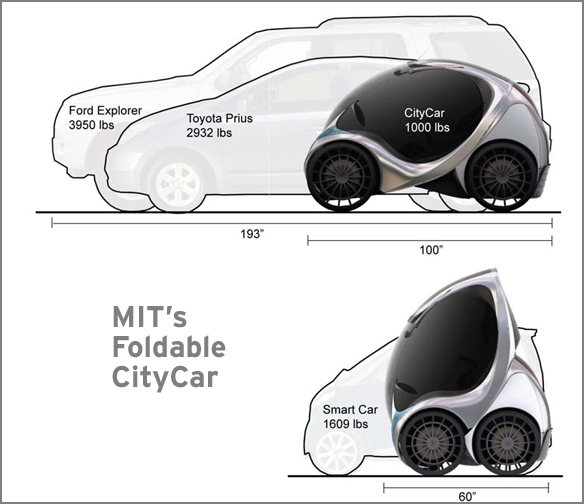Driverless, Folding Cars Are in the Works
With autos that drive themselves, baby boomers may be able to keep their wheels longer.
Leave the driving -- to your car? General Motors' prototype EN-V (Electric Networked Vehicle) promises to let you do just that.
No place to park? The all-electric CityCar, developed by the Massachusetts Institute of Technology, can help out by folding its eight-foot length into a more compact five feet for parking, allowing it to fit in teeny urban spots.
By the end of the decade, both of these well-advanced concepts may be off the drawing board and on the nation's streets and highways.
From just $107.88 $24.99 for Kiplinger Personal Finance
Become a smarter, better informed investor. Subscribe from just $107.88 $24.99, plus get up to 4 Special Issues

Sign up for Kiplinger’s Free Newsletters
Profit and prosper with the best of expert advice on investing, taxes, retirement, personal finance and more - straight to your e-mail.
Profit and prosper with the best of expert advice - straight to your e-mail.
The EN-V's onboard computers will be programmed to take voice commands from the "driver." The computers will then communicate with electronic systems built into roadways so the vehicle can navigate on its own while avoiding hitting other objects.
The car will come equipped with an all-electric, rechargeable power system, eliminating the need for bulky engine, transmission and braking systems. In fact, it won't resemble today's cars much at all. At just a third of the length and weight of today's average car, it'll look more like a bubble or pod.
The car's designers figure it will catch on with aging baby boomers who will want to stay mobile as they get older.
The possibilities with such a vehicle are mind boggling. For example, Dan Flores, a GM spokesman, says EN-V owners will be able to command the cars to drop them off in front of, say, a restaurant. The cars will then park themselves and retrieve their occupants upon command.
Though others, including Google Inc. and Carnegie-Mellon University, are working on electronics for autonomous vehicles, GM is the only entity that’s likely to actually produce commercial models.
MIT's CityCar is a horse of a different color, so to speak. It will require hands-on driving, so motorists will have to keep their eyes on the road. But its shape-altering feature will be a boon to city dwellers, for whom finding a parking space is a frequent challenge.
MIT, which has a working prototype of the folding car, likely will license its technology to a car builder, though it’s too early to say which automakers might be interested.
Development of batteries that are critical to powering the EN-V and CityCar is gaining ground fast. A123 Systems, based in Watertown, Mass., is ramping up lithium battery production at its Michigan plant and will turn out 40,000 or so such batteries a year by mid- to late 2011. Other battery makers, including Johnson Controls-Saft, Milwaukee, and several Japanese and South Korean companies, aren't far behind.
Much of the technology needed to put advanced smart cars on the roads exists today. What's lagging is the infrastructure. Mass-scale manufacturing and deployment of next generation vehicles will have to wait for the needed installation of public recharging stations, embedded sensors and other electronics in roadways, and so on -- work that will take the better part of the decade, at least.

Profit and prosper with the best of Kiplinger's advice on investing, taxes, retirement, personal finance and much more. Delivered daily. Enter your email in the box and click Sign Me Up.
-
 It's Beginning to Look a Lot Like a Santa Rally: Stock Market Today
It's Beginning to Look a Lot Like a Santa Rally: Stock Market TodayInvestors, traders and speculators are beginning to like the looks of a potential year-end rally.
-
 The 2026 Retirement Catch-Up Curveball: What High Earners Over 50 Need to Know Now
The 2026 Retirement Catch-Up Curveball: What High Earners Over 50 Need to Know NowUnlock the secrets of the 2026 retirement catch-up provisions: A must-read for high earners aged 50 and above.
-
 How Much a $100K Jumbo CD Earns You
How Much a $100K Jumbo CD Earns YouYou might be surprised at how fast a jumbo CD helps you reach your goals.
-
 AI Appliances Aren’t Exciting Buyers…Yet
AI Appliances Aren’t Exciting Buyers…YetThe Kiplinger Letter Artificial intelligence is being embedded into all sorts of appliances. Now sellers need to get customers to care about AI-powered laundry.
-
 10 Things You Should Know About Buying a Car Today, Even if You've Bought Before
10 Things You Should Know About Buying a Car Today, Even if You've Bought BeforeIf buying a car is on your to-do list, and it's been a while since you went shopping for a new one, this guide will help avoid any nasty shocks in the showroom.
-
 Banks Are Sounding the Alarm About Stablecoins
Banks Are Sounding the Alarm About StablecoinsThe Kiplinger Letter The banking industry says stablecoins could have a negative impact on lending.
-
 Get the Best Car Deal in Retirement: Here's the Trick
Get the Best Car Deal in Retirement: Here's the TrickPlanning on shopping for a new car this Labor Day weekend? Here’s how to haggle for a better price, even though you're retired.
-
 Big Changes Are Ahead for Higher Ed
Big Changes Are Ahead for Higher EdThe Kiplinger Letter A major reform of higher ed is underway. Colleges are bracing for abrupt change, financial headwinds and uncertainty.
-
 What New Tariffs Mean for Car Shoppers
What New Tariffs Mean for Car ShoppersThe Kiplinger Letter Car deals are growing scarcer. Meanwhile, tax credits for EVs are on the way out, but tax breaks for car loans are coming.
-
 AI’s Rapid Rise Sparks New Cyber Threats
AI’s Rapid Rise Sparks New Cyber ThreatsThe Kiplinger Letter Cybersecurity professionals are racing to ward off AI threats while also using AI tools to shore up defenses.
-
 Blue Collar Workers Add AI to Their Toolboxes
Blue Collar Workers Add AI to Their ToolboxesThe Kiplinger Letter AI can’t fix a leak or install lighting, but more and more tradespeople are adopting artificial intelligence for back-office work and other tasks.